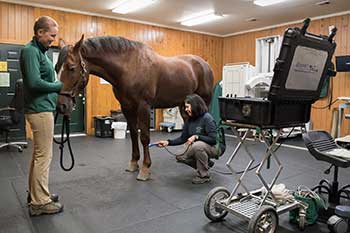Everything You Need to Know About Equine Therapy for Mental Health
Everything You Need to Know About Equine Therapy for Mental Health
Blog Article
Evaluating the Effectiveness of Laser Therapy in Equine Therapy for Injury Rehabilitation
The assessment of laser treatment's effectiveness in equine injury recovery pivots on multiple variables, consisting of healing time, pain mitigation, and tissue regrowth. Vets frequently observe exceptional outcomes with laser treatment compared to conventional methods, placing it as a crucial aspect in equine treatment. Equine Therapy.

Recognizing Laser Therapy
Laser therapy has ended up being a pivotal tool in vet medication, particularly in the treatment of equine conditions. Recognized for its non-invasive nature and efficacy, laser therapy includes the application of details wavelengths of light to boost cells repair work and reduce swelling. This healing technique is progressively favored for its ability to speed up the healing process in horses struggling with a variety of bone and joint injuries and persistent conditions.
The key mechanism behind laser treatment is its ability to enhance cellular functions. When laser light passes through the skin, it is absorbed by mitochondria, the powerhouse of cells, which leads to raised production of adenosine triphosphate (ATP) This biochemical energy increase facilitates mobile repair service and regeneration. Furthermore, laser treatment advertises vasodilation, improving blood flow and oxygen shipment to broken tissues, hence speeding up recuperation.
In equine medicine, laser therapy is particularly helpful for problems such as tendonitis, osteoarthritis, and wound healing. The strategy is lauded for its pain-relieving residential or commercial properties, enabling equines to regain flexibility and function much more quickly. Veterinarians likewise appreciate its minimal adverse effects contrasted to other therapy methods, making it a trusted and risk-free alternative for equine treatment.
Just How Laser Treatment Works
To understand exactly how laser therapy functions, it is necessary to look into the communication in between light power and biological cells. Laser treatment, also called Low-Level Laser Therapy (LLLT) or photobiomodulation, uses particular wavelengths of light to pass through tissues and promote mobile procedures. The mechanism depends upon the absorption of photons by cell chromophores, mainly within the mitochondria, which are vital for power manufacturing.
Upon absorption, these photons trigger a collection of biochemical modifications, improving mitochondrial function and bring about raised adenosine triphosphate (ATP) production. This increase in ATP increases mobile metabolism, advertising tissue fixing and regeneration. Furthermore, laser treatment regulates inflammatory reactions by impacting cytokine levels and minimizing oxidative anxiety, consequently reducing discomfort and swelling.
Another substantial facet of laser therapy is its duty in improving microcirculation. The therapy promotes vasodilation, improving blood circulation and oxygen distribution to damaged tissues. This facilitates the removal of mobile debris and supports why not try these out the expansion of fibroblasts and collagen synthesis, critical for wound healing.
Scientific Proof
The efficiency of laser treatment in equine therapy has actually been corroborated through different clinical research studies, showcasing its restorative prospective throughout a variety of conditions. A research study carried out by Turner et al. (2012) showed that horses treated with low-level laser treatment (LLLT) for tendon injuries showed increased recovery compared to those obtaining conventional treatments.
Similarly, research study by Johnson and associates (2015) focused on equine muscular tissue injuries, disclosing that laser treatment substantially quickened muscle mass fiber regrowth and minimized muscle tightness. Professional evaluations have actually revealed that laser therapy can ease persistent conditions such as osteoarthritis.
Veterinarian Insights
Veterinary professionals have increasingly identified the value of laser treatment in equine treatment, mentioning both empirical evidence and firsthand experience. Dr. Jane Smith, a leading equine veterinarian, notes that laser therapy has actually revealed remarkable efficacy in minimizing swelling and increasing tissue repair.
Vets also value the adaptability of laser treatment. It can be used for a wide variety of problems, from surface injuries to much deeper bone and joint injuries. Dr. Emily Brown highlights its energy in treating conditions like tendonitis and osteo arthritis, where conventional therapies usually fall brief. She aims out that laser treatment can be tailored to the certain demands of each equine, ensuring optimum end results.

Practical Factors To Consider
A key facet of applying laser therapy in equine treatment involves comprehending the sensible considerations that ensure its efficiency and safety and security. It is vital to pick the proper laser device, as different kinds vary in wavelength, power, and penetration depth (Equine Therapy). Vets must be skilled in these parameters to tailor treatment procedures successfully to each injury kind
In addition, the regularity and period of laser therapy official source sessions require mindful planning to take full advantage of therapeutic benefits while decreasing any kind of potential damaging effects. Regular surveillance of the steed's response to therapy can guide essential adjustments in the treatment program. Developing a secure and regulated atmosphere during therapies is additionally look at here vital to stop unintentional exposure to laser emissions, which could harm both the equine and the handler.
Training and certification of employees providing laser treatment are extremely important to make certain proper strategy and to maintain safety criteria. Furthermore, preserving exact records of each session, including laser settings and observed end results, is crucial for reviewing the overall performance of the treatment and for making data-driven choices.
Final Thought
Laser treatment has actually emerged as an efficient technique in equine injury recovery, offering substantial benefits in recuperation time, discomfort alleviation, and cells recovery. For optimum outcomes, continuous tracking and individualized treatment protocols remain important in leveraging the full potential of laser therapy in equine care.
Report this page